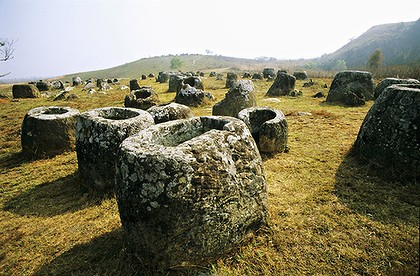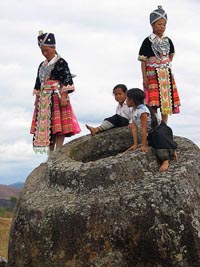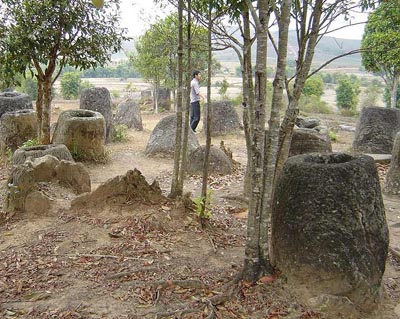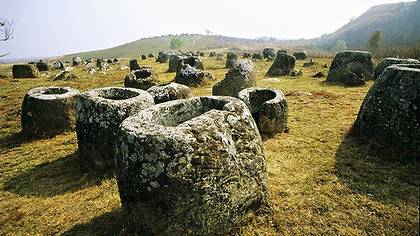The Plain of Jars: A Mystery Pure and Simple
Source: theage.com.au
Steve McKenna studies a bizarre and ancient site that also bears the scars of a more recent 'secret'.
The Plain of Jars in northern Laos is home to a 2000-year-old mystery. Photo: AFP
The Plain of Jars has all the ingredients to stir the imagination. Shrouded in mystery and myth, and laced with intrigue and tragedy, this is a bizarre collection of ancient cylinders scattered in their hundreds across the war-scarred countryside of northern Laos's Xieng Khuang province.
They're believed to have been created by travelling Indian tribes more than 2000 years ago and, as I look at them for the first time, I can't help but think they're an Asian version of Stonehenge – only smaller and with far fewer tourists.
Whereas Stonehenge's ruins tower above visitors, I'm able to peer into most of the lichen-encrusted jars. I'm hoping to perhaps glimpse a few gilded treasures but I spot little more than spiderwebs, birds' feathers and rainwater coated in algae.
Sensing that I'm unimpressed, my guide Tuevee begins regaling me with a story of how he once brought a girlfriend to (a dry) one.
Despite his nods and winks, I'm unconvinced the jars were built with love trysts in mind. They're not just dirty, they don't seem wide enough to hold two people. "Ah," replies Tuevee. "For us small Lao folk, it's OK. For you tall falang (the Lao term for foreigners), it's not so OK."
The jars' origins and purposes still puzzle.
 "Hmong Girls climbing on one of the jars at Site 1 (left)"
"Hmong Girls climbing on one of the jars at Site 1 (left)"Local legend claims they were made of congealed water-buffalo skin so they could store rice and lao-lao (Laos's rice whisky) for a giant who lived nearby.
French archaeologist Madeleine Colani, visiting in the 1930s, established that most were crafted from sandstone (after all, they weigh up to a tonne each) and were probably used for ancient funeral ceremonies.
Colani found a human-shaped bronzed figure carved into one urn and, nearby, a scattering of tiny stone beads, but the lack of organic materials inside the jars, notably bones, has compounded their enigma.
A tour of the jars is also a real eye-opener into the so-called "Secret War", which was launched by the US in the 1960s and '70s and turned Laos into the most bombed country in history.
While the world's attention was on the US-Vietnam conflict, the US showered Laos with more missiles than it dumped on Germany and Japan combined during World War II. Washington's campaign to halt the spread of communism through old Indochina was dubbed the Secret War because Joe Public and, perhaps more remarkably, the US Congress and Senate were unaware of it.
The nine-year campaign wiped out innumerable towns and villages, killed tens of thousands of people and left much of the previously pristine landscape irretrievably damaged and scarred.
At the first of the three major jar sites, remnants of smashed vases lie near old trench lines and bomb craters the size of fairground merry-go-rounds.
The surrounding countryside, pocked with charred bunker mounds and denuded hills and valleys, is largely barren and there is little vegetation apart from pale grass tussocks and a few rows of waif-like, emaciated goblin-green-leaved eucalypts.
It looks more like the interior of a sun-scorched and windswept Greek island than something from the tropics.
The other two jar sites have greener, prettier panoramas, with smatterings of pine forests and irrigated rice paddies but the region largely lacks the verdant lushness that characterises so much of Laos.
The horrendous legacy of the attacks goes deeper than aesthetics, however. About 30 per cent of the bombs dumped on Laos failed to blow up, leaving an estimated 250,000 unexploded ordnance (UXO) scattered throughout the country.
Since 1994, when the British Mines Advisory Group (MAG) set to work here, there has been a huge increase in clearance campaigns and programs that educate locals about the dangers of tampering with suspicious metal objects. Accidents still happen weekly, however, and UXOs are regularly found near schools, in parks and forests and submerged in flooded paddy fields.
MAG, which is co-funded by the US State Department, has an office in the Xieng Khuang provincial capital, Phonsavan.
Its information boards showcase a handful of graphic images, plus statistics on the war and the "bombies" (the bombs' local nickname).
Two things particularly strike me: that the same types of clusters have recently been used in the conflict in Afghanistan and that the average weekly wage for a Lao mine clearer is just $US55 ($69).
MAG's office is the highlight of a rather dusty, uninspiring town, where guest houses and cafes are peppered with Secret War paraphernalia, including huge rockets and hand grenades.
In the evenings, most tourists huddle inside MAG's HQ to watch excellent back-to-back documentaries on the Secret War and its aftermath, including one that follows the Australian mine expert Laith Stevens in his endearing attempts to train budding local bomb detonators.
The film possesses moments that are tragic and funny, bleak and uplifting – emotions that, for me, would encapsulate any visit to this often forgotten, yet fascinating part of Laos.
Article from: TheAge.com.au

The Secret War In Laos (Plain of Jars)
Article from: YouTube.com
Lost In Laos ... The Plain Of Jars
Article from: YouTube.com
David Flynn - The Giant's Geoglyphs of Tiahuanaco
John Anthony West - Ancient Egypt
Michael Tsarion - Irish Origins Part 1 - The West to East Movement of Civilization, Land Bridges & Age of Catastrophe
Researcher claims vast network of prehistoric civilization discovered near Lake Titicaca
Tiahuanaco (Tiwanaku)
Lake Titicaca
Altiplano
Pumapunku & Tiahuanaco
David Hatcher Childress - Technology of the Gods & Ancient Atomic Warfare (Subscription)






















